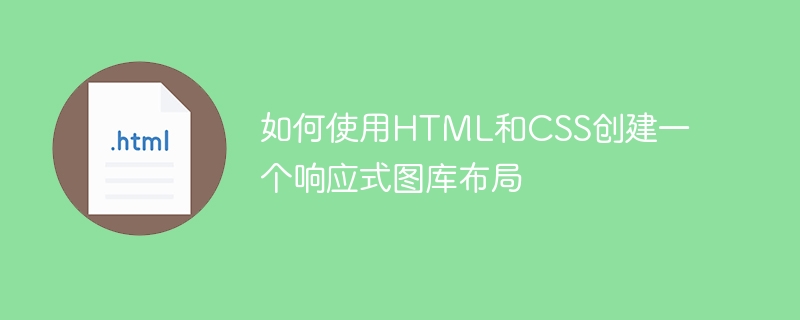Home >Web Front-end >HTML Tutorial >How to create a responsive gallery layout using HTML and CSS
How to create a responsive gallery layout using HTML and CSS
- WBOYWBOYWBOYWBOYWBOYWBOYWBOYWBOYWBOYWBOYWBOYWBOYWBOriginal
- 2023-10-21 11:28:511561browse

How to create a responsive gallery layout using HTML and CSS
Introduction:
With the popularity of mobile devices, responsive design has become important in web design One of the considerations. When developing a gallery website, how to design a page with both beautiful and responsive layout will become an important issue. This article will discuss in detail how to use HTML and CSS to create a responsive gallery layout, and provide specific code examples.
- Design of HTML structure
Before creating the gallery layout, you first need to design the appropriate HTML structure. Here is a simple example:
<div class="gallery">
<figure>
<img src="/static/imghwm/default1.png" data-src="image1.jpg" class="lazy" alt="Image 1">
<figcaption>Image 1</figcaption>
</figure>
<figure>
<img src="/static/imghwm/default1.png" data-src="image2.jpg" class="lazy" alt="Image 2">
<figcaption>Image 2</figcaption>
</figure>
<!-- More images... -->
</div>In this example, we wrap each image with the <figure></figure> element, <img alt="How to create a responsive gallery layout using HTML and CSS" >## The # element is used to display the image, and is used to add a title to the image.
- CSS style design
- Next, we need to style the gallery layout. Here is a basic styling example:
.gallery {
display: grid;
grid-template-columns: repeat(auto-fit, minmax(300px, 1fr));
grid-gap: 20px;
}
.gallery figure {
margin: 0;
}
.gallery img {
width: 100%;
height: auto;
display: block;
}
.gallery figcaption {
text-align: center;
}display: gridConvert the .gallery container to a grid layout. grid-template-columns defines the width of each column. repeat(auto-fit, minmax(300px, 1fr))Indicates the number and size of grid columns, which can automatically adapt to the width of the container, and the minimum width is 300px. grid-gap is used to set the spacing between grid items.
- Responsive design
- In order to achieve responsive layout, we can use media queries (Media Queries). Here is an example:
@media (max-width: 768px) {
.gallery {
grid-template-columns: repeat(auto-fit, minmax(250px, 1fr));
}
}.gallery container when the width is less than 768px. .galleryThe container will be reset to a minimum width of 250px per column.
- Add some interactive effects
- In order to add some interactive effects, we can use CSS transitions (Transitions). Here is an example:
.gallery figure:hover img {
transform: scale(1.1);
transition: transform 0.3s ease;
}
.gallery figure:hover figcaption {
opacity: 1;
transition: opacity 0.3s ease;
}
.gallery figcaption {
opacity: 0;
transition: opacity 0.3s ease;
}hover pseudo-class selector to specify that the mouse is hovering over the .gallery figure element when changing the image's scaling and title's opacity. The transform attribute is used to set the scaling of the image, and the transition attribute is used to set the duration and transition function of the transition effect.
- Summary
- Through the above steps, we can create a responsive gallery layout using HTML and CSS. First, we designed a suitable HTML structure and then added appropriate CSS styles to it. Next, we use media queries to implement a responsive layout and add some interactive effects to enhance the user experience.
The above is the detailed content of How to create a responsive gallery layout using HTML and CSS. For more information, please follow other related articles on the PHP Chinese website!

